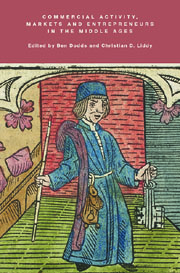 Commercial Activity, Markets and Entrepreneurs in the Middle Ages
Commercial Activity, Markets and Entrepreneurs in the Middle Ages Book contents
- Frontmatter
- Contents
- List of Figures
- List of Tables
- List of Contributors
- List of Abbreviations
- Richard Britnell: An Appreciation
- 1 Unreal Wages: Long-Run Living Standards and the ‘Golden Age’ of the Fifteenth Century
- 2 Minimum Wages and Unemployment Rates in Medieval England: The Case of Old Woodstock, Oxfordshire, 1256–1357
- 3 Crisis Management in London's Food Supply, 1250–1500
- 4 Grain Shortages in Late Medieval Towns
- 5 Market Regulation in Fifteenth-Century England
- 6 Self-Government in the Small Towns of Late Medieval England
- 7 Marketing and Trading Networks in Medieval Durham
- 8 Peasant Opportunities in Rural Durham: Land, Vills and Mills, 1400–1500
- 9 The Shipmaster as Entrepreneur in Medieval England
- 10 Cheating the Boss: Robert Carpenter's Embezzlement Instructions (1261×1268) and Employee Fraud in Medieval England
- 11 The Public Life of the Private Charter in Thirteenth-Century England
- 12 Luxury Goods in Medieval England
- Index of People and Places
- Bibliography of the Writings of Richard Britnell
- Tabula Gratulatoria
8 - Peasant Opportunities in Rural Durham: Land, Vills and Mills, 1400–1500
Published online by Cambridge University Press: 05 February 2013
- Frontmatter
- Contents
- List of Figures
- List of Tables
- List of Contributors
- List of Abbreviations
- Richard Britnell: An Appreciation
- 1 Unreal Wages: Long-Run Living Standards and the ‘Golden Age’ of the Fifteenth Century
- 2 Minimum Wages and Unemployment Rates in Medieval England: The Case of Old Woodstock, Oxfordshire, 1256–1357
- 3 Crisis Management in London's Food Supply, 1250–1500
- 4 Grain Shortages in Late Medieval Towns
- 5 Market Regulation in Fifteenth-Century England
- 6 Self-Government in the Small Towns of Late Medieval England
- 7 Marketing and Trading Networks in Medieval Durham
- 8 Peasant Opportunities in Rural Durham: Land, Vills and Mills, 1400–1500
- 9 The Shipmaster as Entrepreneur in Medieval England
- 10 Cheating the Boss: Robert Carpenter's Embezzlement Instructions (1261×1268) and Employee Fraud in Medieval England
- 11 The Public Life of the Private Charter in Thirteenth-Century England
- 12 Luxury Goods in Medieval England
- Index of People and Places
- Bibliography of the Writings of Richard Britnell
- Tabula Gratulatoria
Summary
Probably upwards of half of County Durham's population died in 1349. Upsetting the ratio of land to labour in an area where serfdom was tottering on the edge of irrelevancy might have opened the door to greater individualism and entrepreneurial activity. Using tithe receipts, Ben Dodds has shown there was a ‘rapid recovery in aggregate output’ in the aftermath of the Black Death that fits A. R. Bridbury's ‘Indian Summer’, and rather than ‘retreating into subsistence production, peasants adopted new techniques and expanded output to meet the demands of the market’. Subsequently, aggregate production relative to pre-plague levels tailed off and there were a number of crises (in the 1390s, 1430s and 1490s); as A. J. Pollard has pointed out, ‘The fifteenth century after 1440 was a bleak era’ for the region, and the period preceding it was not strong either. Nevertheless, producers — including peasants — were able to respond to the market. Opportunities existed for peasants to take a chance to increase their fortunes. By 1500, there were individuals with sufficient resources to lease large parcels of land and even partial or whole vills. One such was John Hall, the son of William Hall, who took up lands in both Bishop Middleham and Sedgefield in 1500; his father had leased the demesne of Bishop Middleham and various parcels, with works, in 1485. In turn, John passed these holdings to his son, another William, in 1537.
- Type
- Chapter
- Information
- Commercial Activity, Markets and Entrepreneurs in the Middle AgesEssays in Honour of Richard Britnell, pp. 141 - 164Publisher: Boydell & BrewerPrint publication year: 2011


